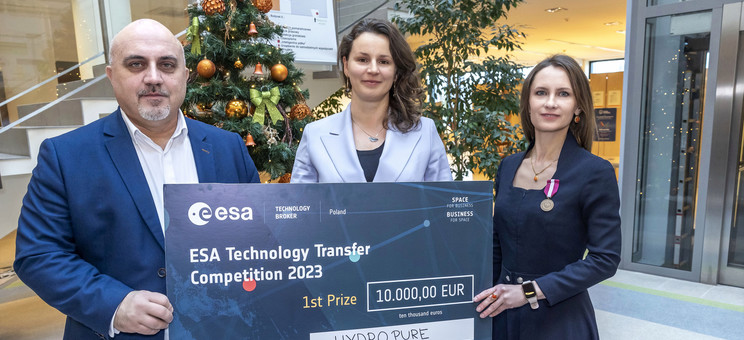First place for researchers in the ESA Technology Transfer Competition

The solution of the 'HydroPure' team, represented by researchers from the Department of Aerospace Engineering at the Faculty of Mechanical Engineering and Aeronautics: Natalia Marszałek, BEng, MSc, Marta Żyłka, BEng, PhD, and Andrzej Majka, BEng, PhD, DSc, Assoc. Prof., won first place in the ESA Technology Transfer Competition. The researchers proposed a technology transfer from the space sector to hydrogen technology based on the ESA Advanced Fluidic Filter patent.
The innovative approach of scientists from the Rzeszów University of Technology and their readiness to transform space technologies into practical terrestrial applications was recognised in the ESA Technology Transfer Competition, organised as part of the SPACE.CONNECT 2023 Conference.
A novel approach to hydrogen purification
"HydroPure" is one of a number of promising projects that bring a novel perspective to the use of space technologies. The 'HydroPure' team's project initiative arose from an interest in the potential for space technology transfer to Earth. The researchers noted that the technologies being developed for the space industry have unique features and advanced solutions that could also be extremely valuable on Earth.
The attention of researchers in the Department of Aerospace Engineering focused on a filter developed by the European Space Agency (ESA), which was initially developed for space applications. Realising the potential of this advanced hydrogen purification filter solution, they decided to turn this space technology into a practical tool for efficient and sustainable hydrogen purification on Earth.
The patented filter developed by the European Space Agency (ESA) is a novel approach to hydrogen purification, using an incremental method in 3D printing from titanium powder. It is characterised by features that make it stand out in the market of available hydrogen filters. These include: high corrosion resistance - the filter is made of titanium material, which makes it highly resistant to hydrogen corrosion, important in the context of hydrogen reactivity, light weight - the titanium material used in the construction of the filter is approx. 40% lighter than stainless steel, which contributes to the efficiency and mobility of hydrogen systems, monolithic design - avoiding welded joints eliminates the risk of hydrogen leakage, which is key to ensuring safety and reliability in hydrogen technologies, multilayer cross-section - minimises filter clogging and pressure drop, which affects the performance and durability of hydrogen systems, notched conical tip - prevents particle accumulation at the filter inlet, keeping the flow field clean and preventing interference, multilayer membrane - traps contaminants of different sizes and shapes, improving hydrogen purity.
Potential for new applications
The filter can be used in hydrogen production, fuel technologies, hydrogen storage, hydrogen vehicles, as well as other areas such as the chemical industry, opening up the possibility to diversify and expand the market scope.
SPACE.CONNECT 2023 Conference
The innovative approach of our scientists was recognised in the ESA Technology Transfer Competition, which was adjudicated during the SPACE.CONNECT 2023 Conference, organised by ESA Technology Broker Poland. The event was devoted to technologies developed by companies from the Polish space sector and technology transfer from the space sector, and its partners were POLSA Polish Space Agency and ESA BIC Poland. The conference provided an excellent opportunity to exchange experience, make new contacts and find potential business partners from the space sector during a matchmaking session.
The European Space Agency's competition was aimed at small and medium-sized enterprises, start-ups, students, PhD students, scientists and individuals from outside the space sector. Its aim was to encourage the commercial use of ESA patents, software and technologies in non-space sectors. Participants could present their ideas for innovative applications of ESA patents, software and technologies, develop their own projects based on ESA resources or present technological solutions relevant to the Polish sector.







